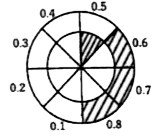Define cardiac cycle.
Step-by-Step Text Solution:
1. Definition of Cardiac Cycle: The cardiac cycle is defined as the series of events that occur from the beginning of one heartbeat to the beginning of the next heartbeat. It encompasses all the mechanical and electrical activities of the heart during this period.
2. Phases of the Cardiac Cycle: The cardiac cycle is primarily divided into two main phases:
- Systole: This is the phase where the cardiac muscles contract. During systole, the heart pumps blood into the arteries. This phase is crucial for the circulation of blood throughout the body.
- Diastole: This is the phase where the heart muscles relax. During diastole, the heart chambers fill with blood in preparation for the next contraction. This phase ensures that the heart has enough blood to pump during the next systolic phase.
3. Cyclic Nature of the Cardiac Cycle: The cardiac cycle operates in a continuous, cyclic manner. After systole is completed, diastole immediately follows without any gap. This seamless transition is essential for maintaining a consistent and effective pumping action of the heart.
4. Importance of the Cardiac Cycle: The cardiac cycle is vital for ensuring that blood is effectively circulated throughout the body, delivering oxygen and nutrients to tissues and organs while also removing waste products.
- Systole: This is the phase where the cardiac muscles contract. During systole, the heart pumps blood into the arteries. This phase is crucial for the circulation of blood throughout the body.
- Diastole: This is the phase where the heart muscles relax. During diastole, the heart chambers fill with blood in preparation for the next contraction. This phase ensures that the heart has enough blood to pump during the next systolic phase.
Topper's Solved these Questions
- BODY FLUIDS AND CIRCULATIONBOOK - CBSE COMPLEMENTARY MATERIALCHAPTER - BODY FLUIDS AND CIRCULATIONEXERCISE - Short Answer Questions-I
3 Videos
- BODY FLUIDS AND CIRCULATIONBOOK - CBSE COMPLEMENTARY MATERIALCHAPTER - BODY FLUIDS AND CIRCULATIONEXERCISE - Short Answer Questions-II
6 Videos
- BiomoleculesBOOK - CBSE COMPLEMENTARY MATERIALCHAPTER - BiomoleculesEXERCISE - Short Answer Questions-II
2 Videos
- BREATHING AND EXCHANGE OF GASES BOOK - CBSE COMPLEMENTARY MATERIALCHAPTER - BREATHING AND EXCHANGE OF GASES EXERCISE - Long Answer Questions
3 Videos
Similar Questions
Knowledge Check
See the following cardiac cycle . For how much duration does joint systole occur in the given cardiac cycle
 A0.4 secondsB0.7 secondsC0.3 secondsDNone
A0.4 secondsB0.7 secondsC0.3 secondsDNonePlease observe the Cardiac Cycle below. For how much duration does joint diastole occur in the given cardiac cycle.
 A0.4 secondsB0.3 secondsC0.7 secondsDNone
A0.4 secondsB0.3 secondsC0.7 secondsDNoneThe correct arrangement of events in the cardiac cycle according to their duration is :
AAtrial systole - Ventricular systole -Ventricular diastole - Atrial diastoleBAtrial systole - Ventricular systole - Atrial diastole - Ventricular diastoleCAtrial systole - Atrial diastole -Ventricular systole - Ventricular diastoleDVentricular systole - Atrial systole - Ventricular diastole -Atrial diastole
Describe the events in cardiac cycle. Explain ’double circulation’.
View SolutionFind out the correct sequence of transmission of cardiac impulse in heart during a cardiac cycle.
View SolutionDraw diagrammatic representation of cardiac cycle. Explain ventricular systole.
View SolutionIn normal ECG, the component that signifies duration of one cardiac cycle is
View SolutionThe given figure indicates three stages in the cardiac cycle

Choose the correct sequence
View Solution